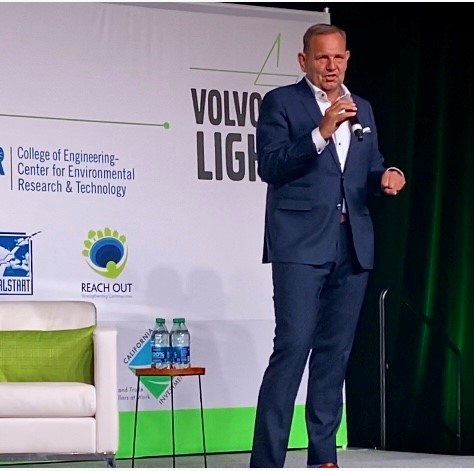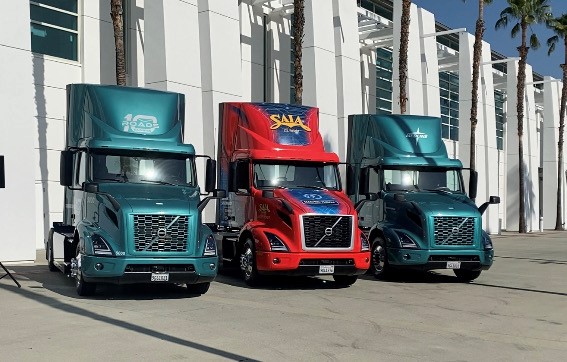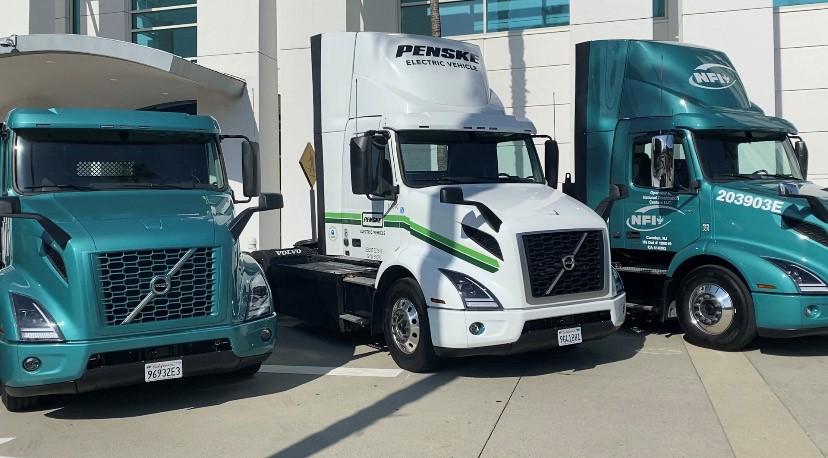Lessons learned from Volvo LIGHTS project
The three-year Volvo LIGHTS (Low-Impact Green Heavy Transport Solution) project is coming to an end this fall, but not before Volvo Trucks North America (VTNA) presented a roundup of findings and lessons learned since the launch of the project in 2019.
Led by Volvo Group North America and California’s South Coast Air Quality Management District (South Coast AQMD), Volvo LIGHTS brought together 14 public and private partners “to design and implement a blueprint for the robust support ecosystem necessary to deploy battery-electric trucks and equipment at scale.”

In February 2020, VTNA introduced its zero-tailpipe emission Class 8 VNR Electric trucks to a pair of Southern California fleets: NFI Industries (NFI) and Dependable Highway Express (DHE). This was a few days before the worldwide pandemic hit. Despite the situation, the project went on and the two fleets piloted the demonstration trucks in their daily routes.
TEC Equipment Fontana, Volvo Trucks’ largest West Coast dealership, was trained and equipped to provide local maintenance and repair support for NFI and DHE’s demonstration trucks and provided access to high-power chargers as needed. Starting in 2021, TEC Equipment also provided the opportunity for local fleet customers representing diverse business sectors — including Albertsons, Penske Truck Leasing, Medline, Saia, Quality Custom Distribution (QCD), 10 Roads Express, Southern California Edison (SCE), and others — to lease Volvo VNR Electric trucks to gain hands-on operating experience and determine where battery-electric trucks might best fit into their routes.
The total project cost was $90 million (all figures U.S.), with a funding award of $44.8 million, amounting to the biggest public-private project in the area.
“This is a story about a great idea, about great partners, about great planning and great execution realizing set goals,” Peter Voorhoeve, president of VTNA, said during the round-up day in California Aug. 23.
Later, TruckNews.com asked him what he was the most proud of at the conclusion of Volvo LIGHTS. “I am proud that it succeeded. Everybody talks electric, low emissions. We haven’t promised anything that we did not deliver. We set the targets and, hand to hand, just delivered everything.”
This pride is legitimate as the idea of the LIGHTS project came at the end of 2018, when Voorhoeve came to North America and assumed the top position. One of the first decisions he had to make was what VTNA will do with electro-mobility and then the decision was made to electrify the VNR. “In great circumstance, we were awarded the leadership of the Volvo LIGHTS project,” he said.
“Partnership is the new leadership,” said Voorhoeve, echoing the words said by Martin Lundstedt, president and CEO of Volvo globally, at the launch of the project two years before.
Volvo Trucks sustainability targets are very clear: by 2030, 50% of its total offering will be zero emissions, and it will be 100% by 2040.

Lessons learned
Thanks to Volvo LIGHTS, real-world operating data were collected and led to many lessons learned, like identifying ideal routes is key to electrification success. Volvo VNR Electric trucks were hauling freight 80 to 150 miles per day as part of the project. The truck’s range can be impacted by several factors, such as the length of the route between stops, topography, and weather conditions. Findings recommend that the fleets, OEM, and dealer work together to understand a fleet’s operational details and identify customer routes and applications that are best suited for electric trucks.
Projects involving the deployment of battery-electric vehicles and charging infrastructure are complex, so assigning a dedicated project manager improves efficiency. “While the OEM or technology providers will have experts who can assist in the vehicle requirements and optimization of operations, it is recommended that fleets identify a dedicated staff person to coordinate all aspects of the project,” notes Volvo LIGHTS’ Lessons Learned Guidebook.
Fleets should think holistically about needs when determining vehicle spec’s. With the advent of battery-electric trucks, fleet operators should engage their OEM and dealer partners to determine the vehicle configurations that will best meet their needs, as limited onboard energy and availability of charging affect the range, charging frequency, and operational duty cycle.
Finally, the Volvo LIGHTS experience suggest to clearly define project requirements up-front. “When fleets transition from conventionally fueled vehicles — like gasoline and diesel — to battery-electric vehicles, there are several infrastructure-related factors to consider. Engaging with an experienced infrastructure partner and turnkey installer is a great first step.”
Two discussion panels concluded the Volvo LIGHTS event. The first one explored real-world experience with heavy-duty battery-electric vehicle deployment.
Larkin Williams is general manager for QCD’s Los Angeles facility, which counts Starbucks among its clients. “One of the things we are really looking for is the quietness of the fleet because our routes run overnight,” he said. Its routes are about 100 miles per day, but include a lot of starts and stops. With 30 new electric trucks coming next year with a range of 250 miles “we should be just fine,” expects Williams.
Jeff Pals, executive vice-president, fleet maintenance for 10 Roads Express says “Customers certainly place high priority in sustainability.” The fleet has one truck involved in the Volvo LIGHTS project and uses a mobile 50 kW charger that suits its needs, but it will eventually have to go further and that involves talking with the utility company. “It’s a very complicated and important process.”
Speaking about maintenance requirements, Pals mentions the efficiency of regenerative braking, and wondered if he “will ever have to do brake job on that truck.”
In the shop, there is a huge learning curve, he said. “Working on these trucks can be life-threatening. It requires training.”
The second panel was about the benefits of electric vehicles for the community.
Diana Fox, executive director of community organization Reach Out, said electric trucks “Will be life-changing to my family and all the families. The community really cares about it. They might not understand all of it, but they know it’s good for the community.”
Implementing a charging network is challenging. “I know someone who has the money to install charging stations between here and Las Vegas, but nobody wants to sell him land to install them.”
Kenny Melancon, faculty chair and associate professor at San Bernardino Valley College raised the financing challenges in training the new technicians. “There are subsidies to buy electric trucks, but there are no subsidies to train those who will maintain those electric trucks,” he said.
To him, there is no doubt: “We are moving into a new technology age.”

Have your say
This is a moderated forum. Comments will no longer be published unless they are accompanied by a first and last name and a verifiable email address. (Today's Trucking will not publish or share the email address.) Profane language and content deemed to be libelous, racist, or threatening in nature will not be published under any circumstances.